EvoLogics Sonobot 5 demonstrates efficiency and effectiveness for underwater mapping
Single-beam and multibeam sonar bathymetry of the Plessower Lake ‘cairn’
The EvoLogics Multibeam, a new multibeam echosounder option for the Sonobot 5 platform, was released at Ocean Business in Southampton, UK, in April this year. In May, EvoLogics conducted its final trials at one of the company’s regular testing sites the Plessower Lake in Brandenburg, Germany. The company is now taking the Sonobot 5 on a summer demonstration tour for partners and clients so that they can see its efficiency and effectiveness for underwater mapping for themselves.
EvoLogics, a German provider of underwater communication, positioning and robotic systems, is known in the industry for its Sonobot 5 uncrewed surface vehicle (USV). Following extensive testing, it has now released the EvoLogics Multibeam, a new multibeam echosounder option for the Sonobot 5 platform, to improve the efficiency and effectiveness of mapping underwater topography. The multibeam sonar for the EvoLogics Sonobot is based on a Norbit OEM solution, an entry-class multibeam sonar with a professional approach.
The Plessower Lake ‘cairn’
Plessower Lake in Brandenburg is a sizable glacial lake known for its good water quality. With an area of approximately 3.22km2, an average depth of 4.5m and a maximum depth of 16m, EvoLogics has been using it as an attractive testing ground for the Sonobot vehicle since 2016. During the Sonobot trials, an interesting discovery was made. Bathymetric data revealed a cairn-like mound formation on the lake floor, measuring about 40m in diameter and 4-5m in height. Initially thought to be an ancient burial mound, it was later determined to be a geological remnant from the last glacial period. This unique feature has made the Plessower Lake an ideal location for testing and demonstrating bathymetric equipment. EvoLogics’ Sonobot vehicles have been regularly returning to the lake to explore and map underwater structures ever since.
Single-beam bathymetry of the Plessower Lake ‘cairn’
Over time, EvoLogics has conducted several bathymetric surveys of Plessower Lake’s mound using the Sonobot equipped with a single-beam echosounder, its most popular configuration. A single-beam echosounder is a valuable tool for various underwater mapping tasks. It emits a narrow high-frequency sound pulse that reflects back when it encounters objects or the lake’s bottom, allowing for depth calculation. Systematically scanning the water creates a bathymetric profile that maps the underwater topography.
Single-beam sonar systems are well-suited for uncrewed surface vehicles due to their simpler design and smaller physical footprint. They use a single transducer, unlike more complex multibeam systems, which require multiple transducers and advanced signal processing. This simplicity allows for seamless integration into compact USVs, optimizing the use of limited resources. The Sonobot 5, equipped with a single-beam echosounder, weighs around 25kg and has dimensions of approximately L 1.29 x W 0.96 x H 0.8m (including antennas), making it easy to handle by a single person. Cost-effectiveness is another factor, as reduced complexity and a lower number of components in single-beam sonar contribute to a more budget-friendly investment for a surveying solution.
During a typical single-beam bathymetry mission with the Sonobot 5, a survey grid is laid out in the mission planning software and loaded into the vehicle. At the site, the Sonobot 5 is launched to perform the automated measurements while travelling along the grid. A live preview of the echosounder data is available at the operator’s shore station during the mission. The full dataset is stored onboard the vehicle to be post-processed and evaluated after the mission.
To obtain the bathymetric profile at the mound site, the vehicle’s path is set for two so-called ‘rows manoeuvres’ (Figure 1). These are a series of parallel paths covering the designated area. The second manoeuvre with a tighter grid above the underwater mound is necessary to obtain more details of the underwater feature. In 2017, EvoLogics performed bathymetry at the mound site using the Sonobot’s standard 200Hz single-beam echosounder and the ‘cairn’ was clearly visible (Figure 3).
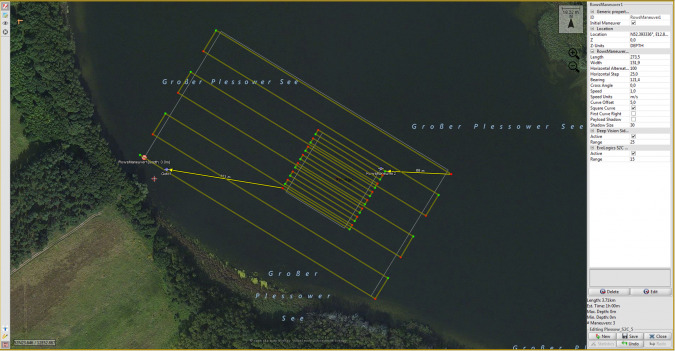
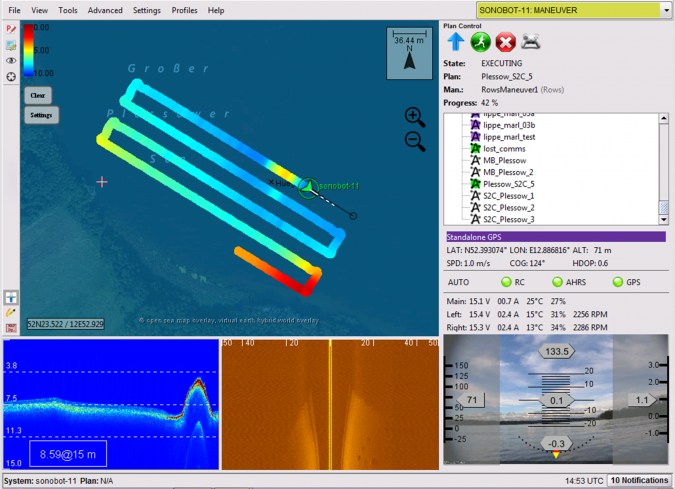
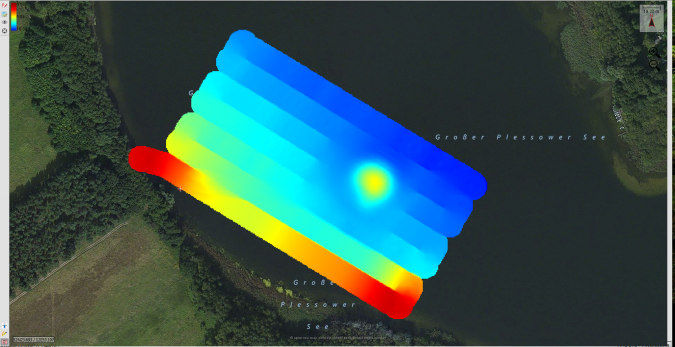
Multibeam vs single-beam
Although the single-beam echosounder technology has its benefits and is well-suited for many applications, modern surveys often require compliance with the IHO’s S-44 standards that define specific accuracy requirements for sonar surveys conducted in hydrographic operations. With the recent release of the EvoLogics Multibeam for the Sonobot 5, the company now addresses the industry’s need for more accurate and efficient bathymetry than is achievable with a single-beam echosounder.
The major advantage of multibeam sonar over single-beam echosounders is that it covers a wider seafloor area. By releasing multiple sound waves simultaneously, it maps large underwater areas quickly, reducing survey time. Another strength of multibeam sonar is its ability to produce high-resolution imagery and detailed 3D representations of underwater features. Furthermore, multibeam sonar provides accurate depth measurements by using advanced algorithms and processing techniques. It compensates for seabed complexities and minimizes the impact of factors like slope, refraction and interference.
Taking these advantages of the multibeam sonar technology and the customers’ requests into account, earlier this year EvoLogics expanded the hardware options of the Sonobot 5 platform with the new release of the EvoLogics Multibeam. EvoLogics Multibeam is based on the Norbit OEM solution and is an entry-class multibeam sonar with 256 beams at 1.45°x1°, a range of over 200m and a ping rate of 50Hz, as well as high-grade dual GNSS and INS positioning and motion control which is standard for all Norbit echosounders.
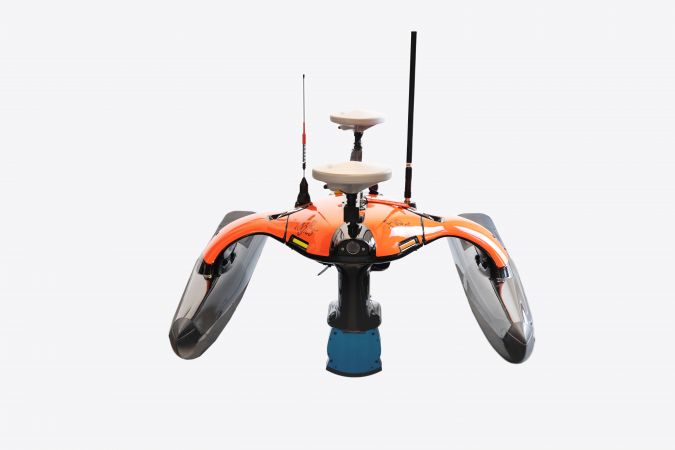
The EvoLogics engineers aimed for seamless integration of the multibeam sonar with the Sonobot 5 platform. The compact Norbit sonar interface unit (SIU) is fully embedded in the submergible pod of the Sonobot vehicle. The sonar head connects to the pod with a single cable that provides power and the data link. Meanwhile, the sonar head is fully detachable from the pod with a simple slide-and-lock mechanism for easy transportation and storage. When the EvoLogics Multibeam is connected to the Sonobot 5, the entire USV weighs under 30kg and measures L 1.29 x W 0.96 x H 1.04m (with antennas). This makes it the smallest and easiest-to-handle autonomous vehicle equipped with a professional multibeam sonar.
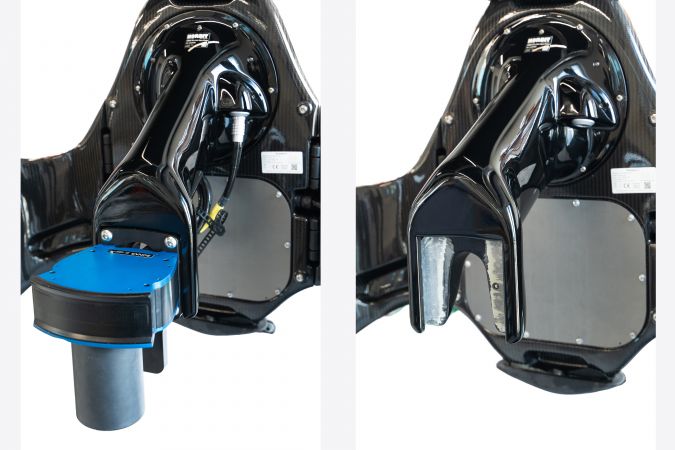
Multibeam bathymetry of the Plessower Lake ‘cairn’
In May 2023, EvoLogics engineers conducted final testing of the Sonobot 5 including the new multibeam sonar at the Plessower Lake site. They took advantage of the known ‘cairn’ or mound feature and existing single-beam bathymetry data to perform a multibeam survey at the same site.
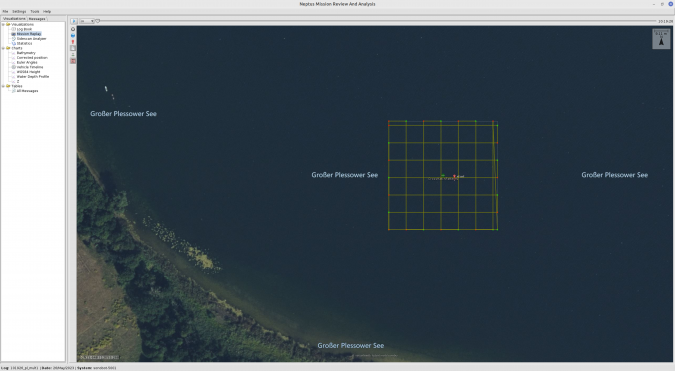
The survey plan EvoLogics chose for the multibeam swath survey at Plessower Lake in May is a crosshatch pattern: a series of parallel lines that are then intersected by another set of parallel lines. The crosshatch pattern allowed the engineers to collect a comprehensive dataset, ensuring there are no gaps in the area coverage.

During a survey, the full sonar dataset is stored onboard the vehicle, with a live preview displayed to the operator at the land station during the mission. The EvoLogics Multibeam is compatible with Norbit data collection tools (DCTs) and NORdredge, Norbit’s web-based utilities for real-time monitoring of multibeam sonar operations. It is also compatible with all third-party software packages currently supported by the Norbit WBMS sonar family.
NORdredge was used for the live multibeam data preview at Plessower Lake. The collected data was subsequently forwarded to EvoLogics’ surveying partners for further post-processing and analysis. However, even without post-processing of the full set of data points, the multibeam sonar data preview was more detailed than the single-beam bathymetry of the area.
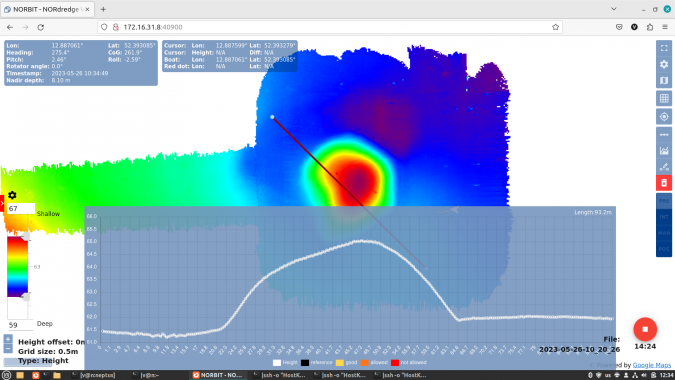
In conclusion, the single-beam echosounder and multibeam sonar surveys conducted at Plessower Lake with the Sonobot USV revealed the advantages and limitations of both techniques. The single-beam echosounder is easier to use, and the simplicity of the data collected simplifies post-processing and interpretation. Conversely, the multibeam sonar system is superior for projects requiring highly accurate and detailed mapping. Therefore, the right choice of echosounder technology depends on the specific survey requirements and the budget.
With the release of the EvoLogics Multibeam, the team are happy to now be able to cater to a wider range of surveying needs and equip survey providers with the flexibility to choose the most suitable technology for their specific projects. The Sonobot 5 with the new multibeam sonar is going on a demonstration tour, as the company gears up for serial production.

Value staying current with geomatics?
Stay on the map with our expertly curated newsletters.
We provide educational insights, industry updates, and inspiring stories to help you learn, grow, and reach your full potential in your field. Don't miss out - subscribe today and ensure you're always informed, educated, and inspired.
Choose your newsletter(s)
























